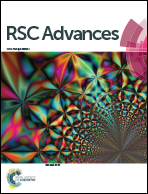Polypyrrole-coated flower-like Pd nanoparticles (Pd NPs@PPy) with enhanced stability and heat conversion efficiency for cancer photothermal therapy†
Abstract
A novel kind of flower-like Pd NPs with strong absorption in the near-infrared (NIR) region was successfully synthesized by using a seed-mediated method in aqueous solutions. The biocompatibilty of the prepared flower-like Pd NPs was improved by coating them with polypyrrole (PPy). In comparison to the pure NPs, the PPy-coated flower-like Pd NPs (Pd NPs@PPy) exhibited stronger NIR absorption, higher structural stability and lower cytotoxicity. Moreover, the photothermal conversion efficiency (η) of the Pd NPs@PPy was effectively tuned via controllably changing the thickness of the PPy shell. A η of 96.0% at 808 nm was reached when the Pd NPs@PPy with a shell of 7.0 nm was prepared. This η was higher than that of the bare flower-like Pd NPs due to the absorption of PPy in the NIR regions. In vitro photothermal heating of Pd NPs@PPy in the presence of HeLa cells led to cell destruction after 10 min of laser irradiation at a low power density of 3 W cm−2. The Pd NPs@PPy shows a potential application as a promising photothermal nanoplatform for cancer therapy.


 Please wait while we load your content...
Please wait while we load your content...